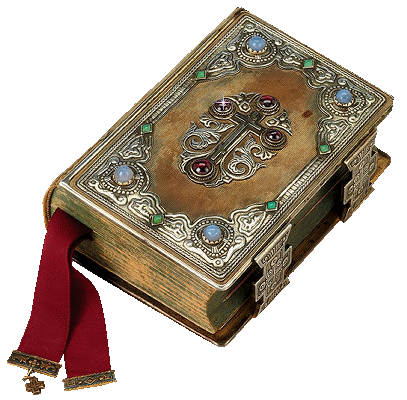 |
Orthodox Outlet for Dogmatic Enquiries | Digital Books |
|---|
CHAPTER 5
NECESSITY OF VENERATION
 |
Orthodox Outlet for Dogmatic Enquiries | Digital Books |
|---|
CHAPTER 5
NECESSITY OF VENERATION
|
Thus far we
have established that the the presence and veneration of the Holy
Icons in the Christian churches are early Christian traditions
inherited from ancient Judaism and also that to attempt to do away
with the Christian iconographic tradition poses significant issues
with radical implications in Christology. We will now build on the
base we have already set in place with these points and move onto
the necessity of the veneration of the Holy Icons.
There are
some Protestant pseudo-iconoclasts who, backing off from full-blown
iconoclasm because its erroneous implications, concede to the
production and presence of iconography but to for its veneration.
Such a semi-iconoclasm, though, is also filled with pitfalls. As we
noted above (Chapter 3) veneration is not only the standardized
ritual common in the Orthodox Church today, but any feeling of awe
or reverence, a feeling which the Holy Icons must naturally bring
about in any pious Christian with a love for Christ, His Holy
Mother, and the Saints and Angels.
This is not
very difficult to illustrate. Imagine that you are away from your
wife or husband, your mother or father, or your son or daughter for
a long period of time. Naturally, you hang up a picture on your wall
or carry a photo of this loved one in your pocket. Each time that
you look at this picture, you experience love and joy. You
contemplate this picture and think about the times you've had with
this person, how much they mean to you, how anxious you are to
return to their embrace. You might even pick that picture up and
kiss it! Now, one might naturally wonder why it would be acceptable,
natural, and normal for you to do all of this for a spouse, parent,
or child, but not to do the same for our Lord and Savior who said,
“Anyone who loves his father or mother more than me is not worthy of
me; anyone who loves his son or daughter more than me is not worthy
of me.”
51
To continue
with the illustration, if one were to look upon a photograph of his
wife whom he has been away from for some time and not feel any love
or desire for her, it would be safe to wonder if he really loves his
wife and wants to be with her. Similarly, if a Christian looks upon
an Icon of his Savior Crucified for his salvation or of his Master
depicted as the Good Shepherd and feels no awe, no reverence, even
no desire to prostrate himself in worship of his Lord, would it not
be safe to wonder if he really loves God and wants to be united to
Him, even if he is a Christian at all?
In short, if
the icons are present, and, as we have seen, they must be present if
we are to have a correct Christology, it is the natural response of
honest love for God that the icons must be venerated. To allow for
the presence of iconography but disallow its veneration is to
separate not only art from utility, a strange enough concept in the
context of ancient thought whether Greco-Roman or Judeo-Christian,
but, more importantly and more spiritually dangerously, to divorce
mind from heart, theology from practice, piety from devotion. St. Theodore of Studium (759-826), a monk and one of the primary Orthodox opponents of the Byzantine iconoclasts, offered a concise summary of this point: “If merely mental contemplation had been sufficient, it would have been enough for him to come to us in a merely mental way.” 52
Notes
51 Matthew
10:37
|
Article posted in English on: 21-1-2015.
Last Update: 21-1-2015.